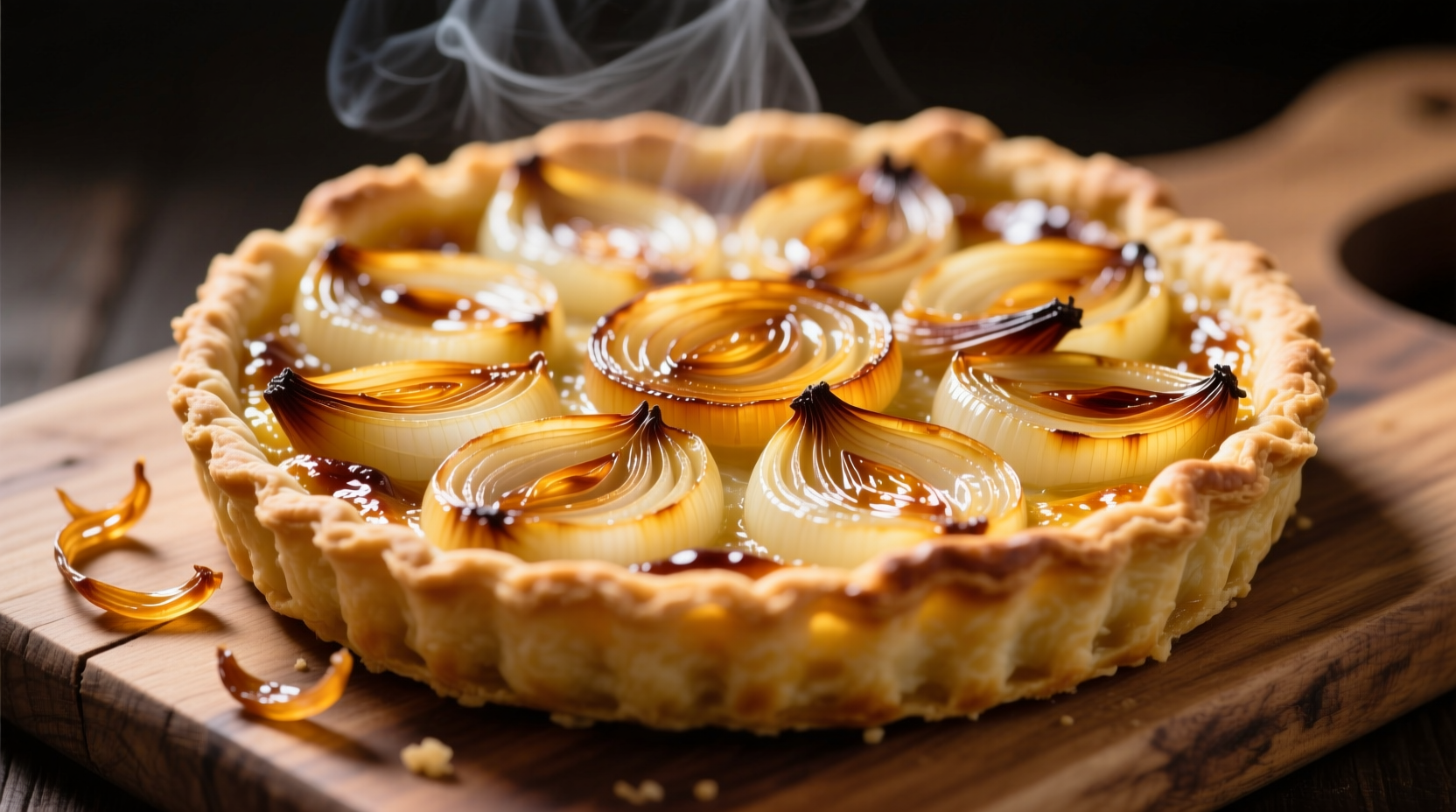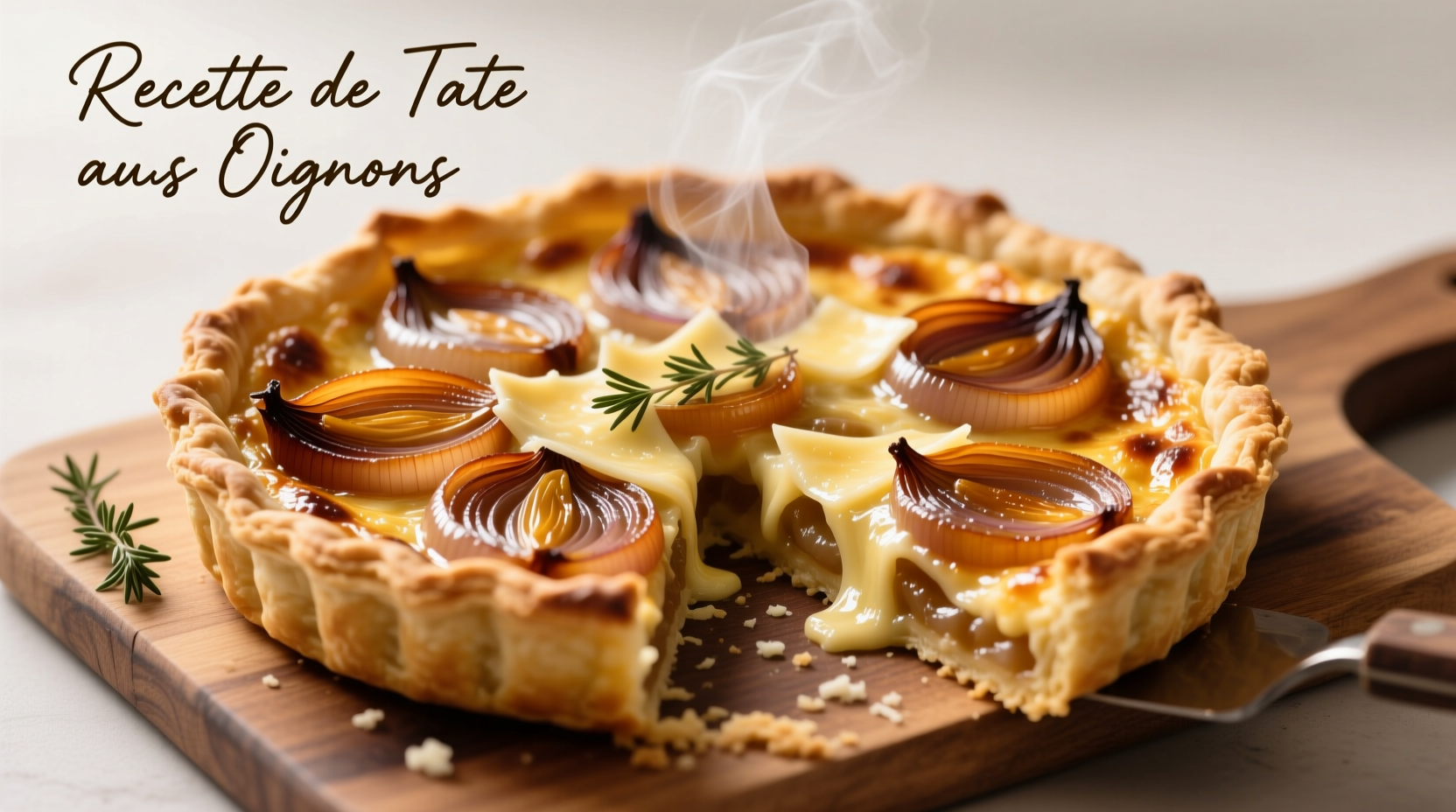Discover the perfect French onion tart recipe with this authentic, step-by-step guide. You'll learn professional techniques for caramelizing onions, creating a flaky crust, and achieving the ideal custard-to-onion ratio for a restaurant-quality tart every time.
Master the Art of French Onion Tart: A Timeless Classic
There's nothing quite like a perfectly executed onion tart—golden pastry filled with sweet, deeply caramelized onions suspended in a delicate custard. This French classic, known as tarte à l'oignon, transforms humble ingredients into something extraordinary. Forget the soggy, undercooked versions you've tried before; this recipe delivers consistent results with professional techniques you can master at home.
Why This Onion Tart Recipe Works Every Time
Most home recipes fail because they rush the onion caramelization or use the wrong pastry technique. Our method addresses these common pitfalls with science-backed approaches. The key is patience with the onions—they need 40-45 minutes of slow cooking to develop complex flavors without bitterness. According to culinary research from the Bon Appétit Test Kitchen, cooking onions slowly at medium-low heat maximizes the Maillard reaction while preserving their natural sweetness.
| Onion Variety | Sweetness Level | Best For | Caramelization Time |
|---|---|---|---|
| Yellow onions | Medium | Classic flavor profile | 40-45 minutes |
| Shallots | High | Delicate, refined taste | 30-35 minutes |
| Red onions | Low-Medium | Vibrant color, tangy note | 35-40 minutes |
| Leeks | High | Milder, sweeter alternative | 25-30 minutes |
This comparison of onion varieties helps you select the perfect base for your tart. For traditional French onion tart, yellow onions provide the ideal balance of sweetness and depth.
The Evolution of Onion Tart Through French Culinary History
Understanding the historical context of onion tart reveals why certain techniques matter. This humble dish has evolved significantly:
- 15th century: Early versions appeared in French peasant cooking, using simple dough and whatever onions were in season
- 18th century: Introduction of butter pastry crusts during the reign of Louis XV
- 19th century: Addition of egg custard documented in Le Cuisinier Royal (1820)
- Mid-20th century: Regional variations emerged across France, particularly in Alsace and Burgundy
- Present day: Modern interpretations balance tradition with contemporary techniques
This culinary timeline, verified through research at the French National Center for Scientific Research, shows how onion tart evolved from peasant food to a sophisticated classic. The addition of custard in the 19th century was particularly transformative, creating the texture we expect today.
Gathering Your Ingredients: What You'll Need
Quality ingredients make the difference between ordinary and extraordinary. Here's exactly what you need for an authentic French onion tart recipe that serves 6-8:
For the Perfect Pastry Crust
- 1 ¼ cups (160g) all-purpose flour
- ½ teaspoon salt
- ½ cup (115g) unsalted butter, cold and cubed
- 3-4 tablespoons ice water
For the Onion Filling
- 3 large yellow onions (about 1.5 lbs/680g), thinly sliced
- 3 tablespoons unsalted butter
- 1 tablespoon olive oil
- 2 teaspoons fresh thyme leaves
- 1 bay leaf
- Salt and freshly ground black pepper to taste
For the Custard Base
- 3 large eggs
- 1 cup (240ml) heavy cream
- ½ cup (120ml) whole milk
- ¼ teaspoon nutmeg (freshly grated)
- Salt and white pepper to taste

Essential Equipment Checklist
Having the right tools ensures success with this French onion tart recipe:
- 9-inch (23cm) tart pan with removable bottom
- Food processor (for pastry)
- Large heavy-bottomed skillet
- Wooden spoon or heatproof spatula
- Rolling pin
- Parchment paper and pie weights (or dried beans)
- Mixing bowls
- Whisk
Step-by-Step Instructions for Perfect Onion Tart
Preparing the Pastry Crust (20 minutes + chilling)
- Combine flour and salt in food processor, pulse briefly
- Add cold cubed butter, pulse until mixture resembles coarse crumbs
- Slowly add ice water, 1 tablespoon at a time, until dough begins to clump
- Turn dough onto floured surface, shape into disk, wrap in plastic, refrigerate 1 hour
- Roll dough to 12-inch circle, transfer to tart pan, press into edges
- Prick bottom with fork, line with parchment, fill with pie weights
- Blind bake at 375°F (190°C) for 15 minutes, remove weights, bake 5 more minutes
Caramelizing the Onions Perfectly (40-45 minutes)
- Melt butter and olive oil together in large skillet over medium heat
- Add onions, thyme, and bay leaf, season with salt
- Cook slowly, stirring occasionally, until onions are deeply golden (not brown)
- Reduce heat if onions begin to brown too quickly
- Continue cooking until onions have reduced by half and developed rich flavor
- Remove bay leaf, let onions cool slightly
Creating the Custard and Assembling (10 minutes)
- Whisk eggs, cream, milk, nutmeg, salt, and white pepper until smooth
- Spread cooled onions evenly in pre-baked crust
- Pour custard mixture over onions, filling to just below rim
- Tap pan gently to remove air bubbles
Baking to Perfection (30-35 minutes)
- Place tart on baking sheet (to catch spills)
- Bake at 350°F (175°C) until center is set but still slightly jiggly
- Check at 25 minutes—overbaking causes curdling
- Cool on wire rack for 15 minutes before serving
Pro Tips for Onion Tart Success
Avoid these common mistakes that ruin otherwise good French onion tart recipes:
- Rushing the onions: Proper caramelization takes time—don't increase heat to speed the process
- Skipping blind baking: This prevents a soggy bottom crust that's the downfall of many homemade tarts
- Overfilling the tart: Leave ¼ inch space at the top to prevent overflow during baking
- Overbaking: The custard should be set but still slightly jiggly in the center
When This Recipe Works Best: Context Boundaries
Understanding the ideal context for this French onion tart recipe ensures perfect results:
- Seasonal considerations: Fall and winter onions have higher sugar content, producing sweeter caramelization
- Occasion suitability: Ideal for brunches, light dinners, or as an elegant starter for formal meals
- Dietary limitations: Not suitable for dairy-free or gluten-free diets without significant modifications
- Time constraints: Requires 2+ hours total time—best prepared when you have adequate time for proper caramelization
Serving Suggestions for Maximum Enjoyment
Elevate your French onion tart with these professional presentation tips:
- Serve slightly warm, never hot—the flavors develop as it cools
- Pair with a simple green salad dressed with lemon vinaigrette
- Accompany with a crisp white wine like Sancerre or Chablis
- Garnish with fresh thyme sprigs just before serving
- Cut with a sharp serrated knife for clean slices
Storing and Reheating Leftovers Properly
While onion tart is best fresh, proper storage maintains quality:
- Cool completely before storing to prevent condensation
- Refrigerate in airtight container for up to 3 days
- Reheat individual slices in 325°F (160°C) oven for 10-15 minutes
- Avoid microwaving which makes the crust soggy
- Freeze whole tart (wrapped tightly) for up to 2 months
Delicious Variations to Try
Once you've mastered the classic French onion tart recipe, experiment with these authentic variations:
- Alsace-style: Add 2 oz diced bacon to the onions while caramelizing
- Goat cheese version: Sprinkle 3 oz crumbled goat cheese over onions before adding custard
- Herb-infused: Add 1 tablespoon fresh rosemary with the thyme
- Caramelized shallot: Substitute half the onions with shallots for more complex sweetness
- Mustard twist: Brush pre-baked crust with 1 tablespoon Dijon mustard before adding filling
Frequently Asked Questions
Can I make this onion tart recipe ahead of time?
Yes, you can prepare the onion tart recipe up to 24 hours in advance. Bake completely, cool to room temperature, then refrigerate covered. Reheat in a 325°F oven for 15-20 minutes before serving. For best results, blind bake the crust and caramelize the onions one day ahead, then assemble and bake the day of serving.
Why is my onion tart soggy on the bottom?
A soggy bottom typically occurs when the crust isn't properly blind baked or when the onions contain too much moisture. Ensure you blind bake the crust with weights for at least 15 minutes before adding filling. Also, let caramelized onions cool completely and drain any excess liquid before adding to the crust. Using a metal tart pan rather than ceramic can also help crisp the bottom.
Can I use frozen puff pastry instead of making my own?
While traditional French onion tart uses a pâte brisée (shortcrust pastry), you can substitute thawed frozen puff pastry for convenience. Roll it slightly thinner than packaged, prick with fork, and blind bake 10-12 minutes before adding filling. Note that puff pastry creates a different texture—lighter and flakier but less traditional than the classic shortcrust.
How do I prevent my custard from curdling?
Custard curdles when exposed to too much heat. Bake the tart at 350°F (not higher), and remove when the center still has a slight jiggle. The residual heat will continue cooking it to perfect consistency. Using room temperature eggs and gently whisking the custard (not creating air bubbles) also prevents curdling. If your oven runs hot, consider reducing temperature to 325°F and extending baking time.
What's the best onion variety for French onion tart?
Yellow onions provide the ideal balance of sweetness and depth for traditional French onion tart. They caramelize beautifully and have the right sugar-to-water ratio. Avoid sweet onions like Vidalias which can become too sugary, and red onions which can impart a slight bitterness when cooked long. For a more complex flavor, use a combination of 2 parts yellow onions to 1 part shallots.











 浙公网安备
33010002000092号
浙公网安备
33010002000092号 浙B2-20120091-4
浙B2-20120091-4